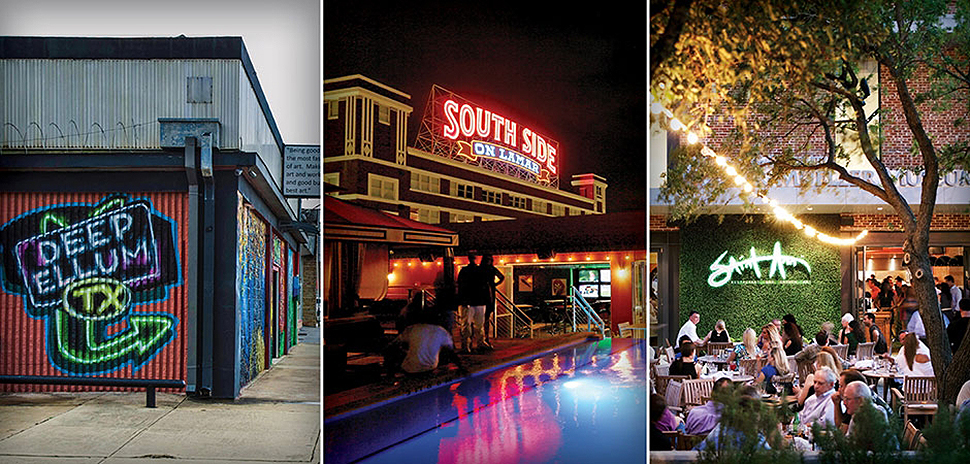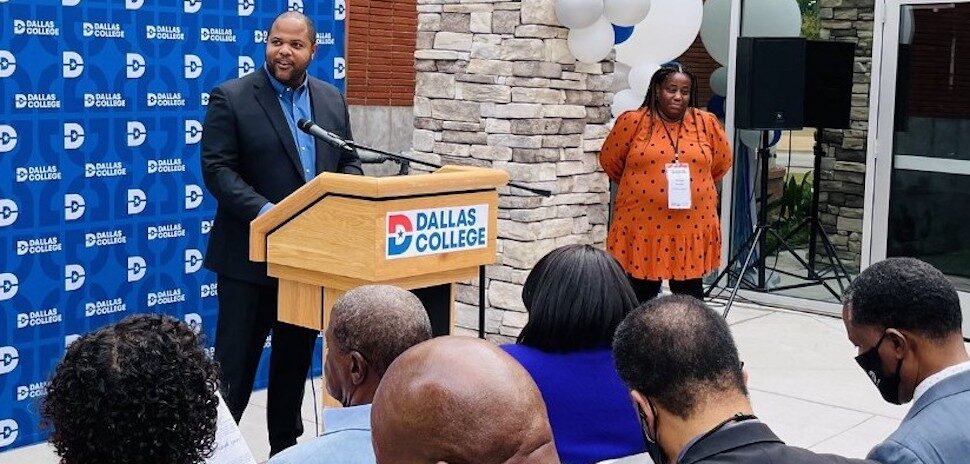Earlier this year, the Census Bureau declared Dallas the second-fastest growing metropolitan area in the nation (behind Houston), with 144,704 people moving to the region between July 2014 and July 2015. For residents who’ve lived here since then, the signs of growth have been evident for a while. Vacant lots have been redeveloped into huge mixed-use communities, empty buildings have been renovated into huge residential and office projects, and areas around downtown Dallas in particular have grown and evolved into distinct neighborhoods with vibrant communities, unique amenities, and eccentric personalities.
Three Dallas pocket markets — Deep Ellum, the South Side on Lamar, and the Harwood District —have been at the forefront of a real estate development boom that’s yielded a swath of new restaurants, retail buildings, offices, and residential projects. Here’s a look at three developers who have breathed new life into these historic parts of town.
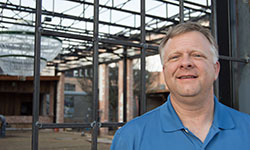
Scott Rohrman
Scott Rohrman, founder, 42 Real Estate
Deep Ellum, the eclectic and notoriously musical neighborhood on the east side of downtown Dallas, has been an important part of Dallas’ historical and cultural fabric for the last century. It’s known for accepting those from all walks of life, and developer Scott Rohrman, whose 42 Real Estate has snapped up more than 50 parking lots and buildings in Deep Ellum, calls it a true melting pot within the city.
“The character — it has an accepting nature; it accepts anybody no matter who they are,” Rohrman said. “And because there’s not a set genre of people, that means nobody fits, but everyone belongs.”
Before breaking ground on a plan to coherently revitalize the neighborhood with plazas and pedestrian-friendly amenities, Rohrman interviewed the people of Deep Ellum — from property and business owners to bartenders, waiters, nightclub operators, musicians, and artists — to find out what they already loved about the neighborhood, as well as what they’d like to see change. One thing seemingly on everyone’s minds is accessibility.
“Urban planning doesn’t always fit a regional transportation mindset, so walkability, interaction with transportation — all those things — can really affect the quality of life of a community.”
Scott Rohrman
“We think there ought to be a transportation line from Fair Park to Trinity Groves running through Deep Ellum and Downtown, and it ought to be on a straight line back and forth so that anyone can know exactly where it’s going to be and when — and it’s not all going all different places, it’s just back and forth from Fair Park to Trinity Groves, probably along Main Street,” Rohrman said. “Urban planning doesn’t always fit a regional transportation mindset, so walkability, interaction with transportation — all those things — can really affect the quality of life of a community. If quality of life of a specific micro community is not taken into consideration, then essentially you’re destroying the fabric of that micro community — and our region is made up of them.”
Rohrman said that putting a finger on the pulse of the community in Deep Ellum has driven a lot of thought processes and logistics behind 42 Real Estate’s planning and development. Although Rohrman couldn’t share specifics at press time, he says there are a few exciting things coming to Deep Ellum. (Offerings will include a bowling alley, an olive oil store, a taco shop, a cold-pressed juice shop, a popsicle store, three new bars, and two new restaurants — and most of the brands are new to DFW.)
He said his favorite project is Radiator Alley, which connects Elm and Main streets with 12 restaurants and retail shops between the Elm Street entrance between Glazed Donuts and Three Links and the Main Street entrance across from Life of Riley. For now, it only has one tenant — an ice cream shop called Chill 360 — and 42 Real Estate will wait until it’s open in about four months to resume leasing.
“We’re trying to save as many buildings as possible, and bring out the bones of them rather than hiding the bones — expose the wood beams and the brick, and we’ve taken more paint off the walls than you can imagine,” Rohrman said.
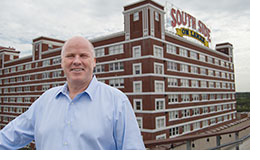
Jack Matthews
Jack Matthews, president, Matthews Southwest
If anyone’s made an impact in South Dallas’ real estate development scene, it’s Matthews Southwest President Jack Matthews. Starting with the historic Sears building, Canada-born Matthews and company have transformed South Lamar Street into a bustling entertainment district that’s also home to the Dallas Police Headquarters.
SouthSide on Lamar is now a vibrant residential and retail complex, but Matthews said it was redeveloped with its own rich history in mind.
“We really just tried to keep as much as that building as we could, so we kept, like, the boiler doors and all sorts of metal that was in the building, and tried to improve all the internal brick walls and expose as many of those as we could,” Matthews said. “And all the columns — we just tried to keep them in as good of shape as possible. We believe that people like history, and they like sort of being able to touch it, feel it, and understand it. This kind of offered us the ability. The more of it we could keep, the more people liked it.”
“We believe that people like history, and they like sort of being able to touch it, feel it, and understand it.”
Jack Matthews
Matthews also developed Gilley’s Dallas, which sits near SouthSide on Lamar and has a 26,000-square-foot South Side Ballroom that can accommodate up to 3,800 country music fans, of which Matthews is one. He also led the development of the highly anticipated $500 million Omni Dallas Convention Center Hotel, which opened ahead of schedule in 2011. In 2012, he opened another hotel, the 76-room boutique NYLO Dallas South Side. Throughout all of this development, Matthews said he aims to blend the old and the new.
“We convinced Bill’s Records to come into the area just because we like the idea of an old record store,” Matthews said. “We also like to have effectively no national brands. It’s not that we don’t like national brands; we want something unique. … If you come to that area, you’re experiencing part of real Dallas.”
Matthews recently brought the “last piece” to the South Side neighborhood with Alamo Drafthouse, because he said he liked the vibe of the way they showed movies and provided other cinematic programming. And it’s been wildly successful (Matthews said it’s coming close to doubling the nighttime population of the neighborhood). Another addition, Opening Bell Coffee, was chosen in favor of a big-box coffee brand for its own unique personality — and the fact that it fits in well with the musical neighborhood by offering live music six nights a week.
And Matthews’ work in the South Side is far from finished. Plenty of things are in the works, but the biggest, he said, is the Dallas station along the proposed 240-mile high-speed rail that would connect Dallas and Houston.
“The high-speed rail comes into the north corner of it, and we’re working on more residential,” Matthews said. “There’s an old building that’s right beside South Side Studios — it’s quite large, it’s an old cotton building — and we’re getting ready to dust that off and try to put some more residential in. … We really want to be open to every type of person — any which way you make a person, we want to be open to that, and kind of be seen as a melting group in Dallas.”
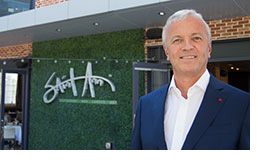
Gabriel Barbier-Mueller
Gabriel Barbier-Mueller, founder and CEO, Harwood International
When you drive around the Harwood District, it’s nearly impossible to miss the Swiss cow-adorned cranes hovering above you. That’s because Harwood International, led by Switzerland-born founder and CEO Gabriel Barbier-Mueller, has a swath of developments underway across his 17 city blocks that comprise the Harwood District of Dallas.
But it all started with Harwood No. 1, or the Rolex Building, which was built to suit the Swiss watchmaker in 1984 and became Uptown Dallas’ first office building. Harwood No. 2 at 2728 N. Harwood St., another office building whose 10 stories were designed by architect Richard Keating and that houses Marie Gabrielle Restaurant and Gardens. Harwood No. 3 at 2727 N. Harwood St., also designed by Keating, came in 1999 and today houses Magnolias: Sous Le Pont restaurant. Harwood No. 4 at 2828 N. Harwood St. was built in 2000 and features a collection of antique horses and mounted knights in full armor atop an under-lit glass aggregate of more than a million blue glass rocks. Barbier-Mueller and company took a short break before building Harwood No. 6, now known as Saint Ann Court, in 2009. This building is home to Saint Ann Restaurant & Bar, as well as The Ann & Gabriel Barbier-Mueller Museum: The Samurai Collection. Harwood No. 7, Frost Tower, came in 2015 with Polsinelli and Rochon Family Office as lead tenants. All and all, these buildings were 96 percent occupied at press time.
Harwood International also has several unfinished projects underway: the 22-story Harwood No. 10, a Class AA office tower with 9,000 square feet of retail and restaurant space and adjacent gardens on its ground level; and Harwood No. 8, The New Rolex Building, which will provide 56,422 square feet of office space across seven stories.
At press time, the Harwood District was home to seven exclusive restaurants — Happiest Hour, Mercat Bistro, Saint Ann Restaurant & Bar, Marie Gabrielle Restaurant & Gardens, Magnolias: Sous Le Pont, The Grove at Harwood, and Dolce Riviera, which opened its doors this fall as the district’s most formal and only by-reservation eatery. Harwood’s latest residential project, Blue Ciel, will open in summer 2017 and features 33 stories of luxurious two- and three-bedroom homes ranging from 1,300 to more than 7,000 square feet and priced starting in the $800,000s. It will join Harwood’s Azure, which was built in 2007 and stands 31 stories high.
This article originally appeared in the Dallas-Fort Worth Real Estate Review.
Delivering what’s new and next in Dallas-Fort Worth innovation, every day. Get the Dallas Innovates e-newsletter.










